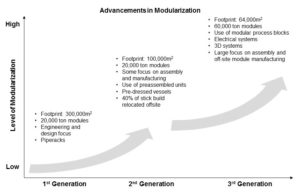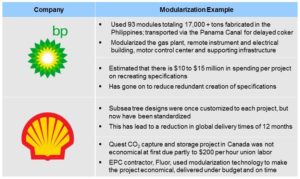
Capital projects drive growth in the oil and gas industry and, yet, are plagued by cost and schedule overruns. In 2015 there were an estimated 800 oil and gas projects costing over $500 billion and one-third will end up facing delays. Operators are constantly searching for ways to improve performance, meet schedules, and reduce costs. This is particularly important in the low-oil price environment that companies are facing today.
Modularization and standardization can help improve the delivery and cost performance of capital projects in the oil and gas industry. These terms refer to the practice of using standardized methods and equipment with the aim of reducing redundancy and thereby time and costs across projects. Modularization and standardization are often used in tandem, but are different from each other. Modularization is the practice of using similar components and equipment, often prefabricated at an off-site location, to reduce time and costs. Standardization is the practice of using methods across many different projects.
There benefits from implementing both modularization and standardization: There is a significant amount of opportunity for companies to implement modularization and standardization. It is estimated that the correct implementation of standardization and modularization can reduce overall time by 20% as well as costs by up to 15%. For example, BP has estimated that $10-$15 million dollars are spent per project on recreating procurement specifications. Streamlining this process would be an example of standardization. Even though companies like BP have identified areas where modularization and standardization can be applied, there has been limited application of these practices across the industry. Figure 1 shows the percentage range of projects where standardization can be applied across the oil and gas value chain.
Modularization has grown and is now having a large impact on capital projects: Although there has been a lot of talk about standardization and the cost and scheduling benefits are well understood, there has been limited application until now. This is reinforced in a recent comment by the CEO of FMC Technology, John Gremp, and some insight he offered at the 2015 Offshore Technology Conference, when he said, “I think if I hear the word standardization (again) I am probably going to go nuts. We have been talking about this for at least three decades, and yet the ability to truly standardize our industry has eluded us – until maybe now.”
Modularization has expanded from being centered around processes and engineering to encompassing almost all aspects of capital projects. Further, a number of projects of varying types have reported the use of modularization. Figure 2 shows how modularization has expanded over multiple project and technological cycles.
For example, both Shell and BP have successfully deployed modularization in their recent capital projects. Shell has chosen to modularize subsea tree platforms and the result has been a reduction in delivery times by as much as 12 months. Additionally, a CO2 recovery project in Canada, Quest, was not economical during the planning stages due primarily to high labor costs from construction workers. However, after the EPC contractor, Fluor, applied its third generation of modularization practices, the project it became economical. The project was recently completed under budget and on time.
As another example, BP chose to modularize a delayed coking unit in Whiting, IN. The $1.3 billion dollar project included 93 modules weighing over 17,000 tons. The modules were constructed in the Philippines and shipped to the United States via the Panama Canal and then ultimately though Lake Michigan. Figure 3 shows several examples of how BP and Shell have implemented modularization.
Modularization can lead to issues if done incorrectly or managed poorly: There are several hurdles that an operator must address to successfully deploy and benefit from modularization. For example, an operator must manage two different work sites: the main project site and the fabrication site for the modularized pieces. This can lead to communication and logistical gaps if not managed properly. Transporting the modules themselves can be difficult if they are too large or heavy to be transported by road. This leads to a need for greater logistical planning preceding a capital project. Once the modules are delivered to the site there must also be a greater level of coordination to ensure that the facility is constructed properly. Lastly, with most of the work being done before the modules are assembled, there is a need for a large amount of front end engineering.
Although there are some hurdles that must be overcome before an operator can successfully implement standardization and modularization into a project, the benefits of a reduced construction time, lower overall cost, and successful implementation from major players in the industry suggest it is growing more attractive.
-Tyler Wilson and Uday Turaga






















